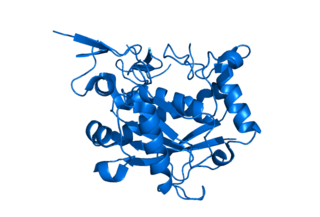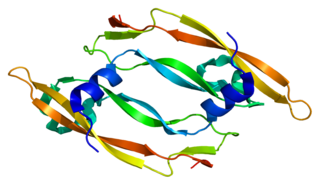
Pleiotrophin (PTN) also known as heparin-binding brain mitogen (HBBM) or heparin-binding growth factor 8 (HBGF-8) or neurite growth-promoting factor 1 (NEGF1) or heparin affinity regulatory peptide (HARP) or heparin binding growth associated molecule (HB-GAM) is a protein that in humans is encoded by the PTN gene. Pleiotrophin is an 18-kDa growth factor that has a high affinity for heparin. It is structurally related to midkine and retinoic acid induced heparin-binding protein.

Angiopoietin 1 is a type of angiopoietin and is encoded by the gene ANGPT1.

Angiopoietin-2 is a protein that in humans is encoded by the ANGPT2 gene.

Angiopoietin-1 receptor also known as CD202B is a protein that in humans is encoded by the TEK gene. Also known as TIE2, it is an angiopoietin receptor.

Lysophosphatidic acid receptor 2 also known as LPA2 is a protein that in humans is encoded by the LPAR2 gene. LPA2 is a G protein-coupled receptor that binds the lipid signaling molecule lysophosphatidic acid (LPA).

Sphingosine-1-phosphate receptor 2, also known as S1PR2 or S1P2, is a human gene which encodes a G protein-coupled receptor which binds the lipid signaling molecule sphingosine 1-phosphate (S1P).

Chemokine-binding protein 2 is a protein that in humans is encoded by the CCBP2 gene.

Lysophosphatidic acid receptor 3 also known as LPA3 is a protein that in humans is encoded by the LPAR3 gene. LPA3 is a G protein-coupled receptor that binds the lipid signaling molecule lysophosphatidic acid (LPA).

A disintegrin and metalloproteinase with thrombospondin motifs 1 is an enzyme that in humans is encoded by the ADAMTS1 gene.

Junctional adhesion molecule C is a protein that in humans is encoded by the JAM3 gene.

Chloride intracellular channel 4, also known as CLIC4,p644H1,HuH1, is a eukaryotic gene.

Junctional adhesion molecule B is a protein that in humans is encoded by the JAM2 gene. JAM2 has also been designated as CD322.

Sulfhydryl oxidase 1 is an enzyme that in humans is encoded by the QSOX1 gene.

Vascular endothelial growth factor B also known as VEGF-B is a protein that, in humans, is encoded by the VEGF-B gene. VEGF-B is a growth factor that belongs to the vascular endothelial growth factor family, of which VEGF-A is the best-known member.

Angiopoietin-like 3, also known as ANGPTL3, is a protein that in humans is encoded by the ANGPTL3 gene.

Angiopoietin-4 is a protein that in humans is encoded by the ANGPT4 gene.

Angiomotin-like protein 1 is a protein that in humans is encoded by the AMOTL1 gene.

Angiopoietin-related protein 2 also known as angiopoietin-like protein 2 is a protein that in humans is encoded by the ANGPTL2 gene.

Protocadherin-12 is a protein that in humans is encoded by the PCDH12 gene.

Apolipoprotein F is a protein that in humans is encoded for by the APOF gene. The product of this gene is one of the minor apolipoproteins found in plasma. This protein forms complexes with lipoproteins and may be involved in transport and/or esterification of cholesterol.




















